
The Breed History
In China about 150 BC, art depicts a Spitz type dog such as this, but
it is likely the breed developed earlier in time. History records the
presence of these types of dogs during the Tartar invasion of China
about 1000 BC. Perhaps the Siberian Husky and Tibetan Mastiff
were the breed progenitors or were offshoots from this breed. The
name chow chow is a generic shipping term for "such and such" in
the cargo hold, also chow may derive from chou, Chinese for edible.
Whatever the real meaning, the dogs were given this nickname.
They were first brought to England in the year 1880. The AKC
admitted the breed in 1903.
Breeding for Function
The Chow has fulfilled many roles over the centuries including
hunting by scent for pheasant and other game, companionship,
livestock guard dog, pulling loads, producer of fur for clothing, and
in China, as a food source.
Physical Characteristics
Height at Withers: 17-20" (43-51 cm)
Weight: 45-70 lb (20-32 kg)
Coat: The double coat is present in two varieties: a short smooth coat
and a longer rough coat that stands out. The latter is much more
common. Short-coated dogs have a distinct undercoat and the outer
coat is dense, hard, and smooth in texture and no feathers or ruff are
evident. Colors are solid to solid with shading. Colors accepted include
red, black, blue, cinnamon and cream. Whites are very rare.
Longevity: 11-12 years.
Points of Conformation: The Chow has an arctic type with a square
strong broad build and compact conformation. The blue tongue
and compressed scowling face characterize the breed. The bone
is also heavy, muscling moderate and the haircoat is profuse. The
head is broad and flat, and the muzzle is blocky. He possesses a high
head carriage, and the oblique almond-shaped eyes are deep and
wide set with dark brown color. They have tight darkly pigmented
palpebral margins. Ears are pricked, small and the leather is moderate
in thickness, with slightly rounded tips. On the face, one sees a
moderate stop, brows well developed, and the large black nose has
well opened nostrils. A slate nose may be present in blue coat colored
chows. Lip margins, and all oral cavity membranes are black and
the tongue is blue-black. The neck is full, well muscled and arched,
the topline is straight and level, and ribs are well sprung. Limbs
are straight, dewclaws may be removed, and feet are compact and
sit on well-knuckled toes. A broad pelvis is evident. The tail is well
feathered. The long rough coated dogs possess a well-developed
ruff, especially in males (sometimes referred to as lion-like). The
tapered tail is set high and carried over the back and covered with a
profusion of hair. The normal gait is stilted due to the conformation
of the rear limbs (straight through both tarsus and stifle).
Recognized Behavior Issues and Traits
Reported attributes of the breed include: Independent, dignified,
confident, willful, high intelligence, can be aggressive to other dogs
and small pets, aloof with strangers and may attack due to their
guarding heritage. Overall, on average have dominant personalities.
Their eye placement may trigger defensive responses due to their
inability to access the full visual field; may be snappy and will bite
if provoked, can tend to be a one-person dog. Early obedience is
important, and early socialization is essential to discourage the
aforementioned tendencies in some dogs. Should be raised with
children or socialized thoroughly and children should be taught
how to treat the dog. They need daily grooming to maintain a good
coat. These are high shedding dogs. They have moderate exercise
needs and are easily housebroken, and have a low doggy odor. They
are considered good alarm barkers. They do not tolerate heat and
humidity well.
Normal Physiologic Variations
Lip margins, and all oral cavity membranes are black and the tongue
is blue-black.
A study in the UK shows 28.1% of litters are born via C-section.
Drug Sensitivities
None reported
Inherited Diseases
Elbow Dysplasia: Polygenically inherited trait causing elbow
arthritis. OFA reports 47.6% affected. Found at a higher incidence
than reported by the OFA in South Africa. Reported 16.6x odds ratio
for fragmented coronoid process, 13.3x odds ratio for ununited
anconeal process forms of elbow dysplasia, and 108.8x odds ratio
for elbow osteochondrosis versus other breeds.
Hip Dysplasia: Polygenically inherited trait causing degenerative
joint disease and hip arthritis. Reported 5.4x odds ratio versus other
breeds. OFA reports 19.6% affected.
Patella Luxation: Polygenically inherited laxity of patellar
ligaments, causing luxation, lameness, and later degenerative joint
disease. Treat surgically if causing clinical signs. Reported 6.1x odds
ratio versus other breeds. OFA reports 11.4% affected.
Congenital Myotonia: Rare, autosomal recessive congenital
disorder that causes hindlimb ataxia, a stiff gait, and occasional
collapsing. The severe muscle stiffness regresses with exercise.
Treatment is with procainamide.
Disease Predispositions
Persistent Pupillary Membranes: Strands of fetal remnant
connecting; iris to iris, cornea, lens, or involving sheets of tissue.
The later three forms can impair vision, and dogs affected with
these forms should not be bred. Severely affected Chow Chows
can be temporarily or permanently blind due to adherence to
the cornea or lens. Dorn reports a 3.89x odds ratio versus other
breeds. Identified in 46.45% of Chow Chows CERF examined by
veterinary ophthalmologists between 2000-2005, with 45.16%
iris to iris, 4.19% iris to cornea, and 1.29% iris to lens. CERF does
not recommend breeding any Chow-Chows with the later two
categories of PPM.
Entropion: A rolling in of the eyelids that can cause corneal
irritation and ulceration. It is reported in 39.35% of Chow Chows
CERF examined by veterinary ophthalmologists between 2000-2005.
Dorn reports a 14.64x odds ratio versus other breeds. CERF does not
recommend breeding affected Chow Chows.
Hypothyroidism: Inherited autoimmune thyroiditis. 7.4% positive
for thyroid auto-antibodies based on testing at Michigan State
University. (Ave. for all breeds is 7.5%).
Pemphigus Foliaceus: The breed has an increased risk (12.3x
odds ratio) of developing pemphigus foliaceus. Clinical signs
include crusting lesions to the dorsal part of the muzzle and head,
progressing to the body. Diagnosis is with biopsy.
Aggression: Chow Chows are significantly over represented in
human bite cases with a 4.0x odds ratio versus other breeds.
Primary (Narrow Angle) Glaucoma: Ocular condition causing
increased pressure within the eyeball, and secondary blindness
due to damage to the retina. Primary glaucoma in the breed is
a bilateral condition due to narrow iridocorneal angles, with an
age of onset of 3-6 years. One study shows 4.70% Chow Chows
affected. A female preponderance occurs in the breed. Monitor with
gonioscopy and tonometry. Dorn reports a 1.35x odds ratio versus
other breeds. CERF does not recommend breeding affected Chow
Chows.
Cranial Cruciate Ligament Rupture: The Chow Chow has a
predisposition for cruciate ligament rupture, due to its straight hind
leg conformation. Treatment is with surgery.
Corneal Dystrophy: Chow Chows have been identified with both
the epithelial/stromal and endothelial forms of corneal dystrophy.
Identified in 1.94% of Chow Chows CERF examined by veterinary
ophthalmologists between 2000-2005. CERF does not recommend
breeding affected Chow Chows.
Exposure Keratopathy Syndrome: Corneal reactivity and drying
from ocular exposure secondary to shallow orbits, exophthalmos,
and lagophthalmos. Identified in 1.61% of Chow Chows CERF
examined by veterinary ophthalmologists between 2000-2005.
Ectropion: Ectropion, a rolling out of the eyelids, can cause
frequent conjunctivitis, and ocular discharge. It is reported in 1.61%
of Chow Chows CERF examined by veterinary ophthalmologists
between 2000-2005.
Chronic Superficial Keratitis (Pannus): Chronic corneal
inflammatory process that can cause vision problems due to
corneal pigmentation. Treatment with topical ocular lubricants
and anti-inflammatory medication. Identified in 1.29% of Chow
Chows CERF examined by veterinary ophthalmologists between
2000-2005.
Cataracts/Congenital Cataracts with Ocular Anomalies: Inherited
disorder causing congenital cataracts, sometimes associated with
wandering nystagmus, entropion, microphthalmia, persistent
pupillary membrane remnants, and multifocal retinal folds.
Unknown mode of inheritance. Cataracts are identified in 1.29%
of Chow Chows CERF examined by veterinary ophthalmologists
between 2000-2005. CERF does not recommend breeding any Chow
Chow with a cataract.
Alopecia-X (Black Skin Disease, BSD, Coat Funk): Progressive,
symmetrical, non-pruritic, truncal hair loss usually beginning in
early adulthood. ACTH, LDDS, and thyroid panel results are normal.
Oral trilostane reverses the condition in some cases. The disorder
appears to be familial.
Sebaceous Adenitis: Disorder of immune mediated sebaceous
gland destruction, presenting with hair loss, hyperkeratosis and
seborrhoea, usually beginning with the dorsal midline and ears.
Diagnosis by skin biopsy. Treat with isotretinoin. Reported at an
increased frequency in the breed.
Gastric Carcinoma: Chow Chows have the highest frequency of
gastric carcinoma compared with other breeds. The most frequent
clinical features are vomiting, polydipsia and weight loss, with
endoscopic findings of a large deep ulcer with thickened, irregular
rims and walls.
Gastric Dilatation-Volvulus (bloat, GDV): Polygenically inherited,
life-threatening twisting of the stomach within the abdomen.
Requires immediate treatment. Reported at an increased frequency
in the breed.
Oral and Lingual Melanoma: Chow Chows have a higher incidence
of oral melanomas versus other breeds. One study found a 7.89x
relative risk versus other breeds. The gingival, labial mucosa, and
tongue are the most common sites. Average age of onset is 11.4
years.
Pulmonic Stenosis: Congenital malformation of the pulmonic
valve. Causes stricture of the right ventricular outflow tract or
stricture of the pulmonary artery. Screen with auscultation and
echocardiography. The Chow Chow has a 2.2x odds ratio for the
condition versus other breeds. Unknown mode of inheritance.
Atrioventricular Block (AVB): Chow Chows are predisposed
to high-grade second- or third-degree AVB. Weakness, lethargy,
exercise intolerance, and syncope were the most common clinical
signs. Recommended treatment is pacemaker implantation.
Pancreatic Acinar Atrophy (Exocrine pancreatic insufficiency):
Chow Chows are a breed at risk for immune-mediated pancreatic
acinar atrophy. Clinical signs are poor weight gain, and steatorrhea.
Treatment is with enzyme supplementation. Breeding studies
suggest an autosomal recessive mode of inheritance in German
shepherd dogs, another breed found at risk.
Familial Juvenile Renal Disease: Kidney disorder seen in young
Chow Chows causing classical polyuric, azotemic renal failure with
anemia. Pathology includes interstitial fibrosis, small glomeruli, and
lack of inflammatory cells. Unknown mode of inheritance.
Atresia Ani (Imperforate Anus): An increased incidence of this
congenital condition is reported in the breed, with a frequency of
0.043%, and an odds ratio of 8.90x. Treatment is surgery.
Dysmyelination of the Central Nervous System: Rare, inherited
congenital disorder causing whole body tremors. Affected dogs can
survive with clinical signs. Unknown mode of inheritance.
Cervical Vertebral Instability, Color Dilution Alopecia,
Dermatomyositis, Diabetes Mellitus, Epilepsy, Hypoadrenocorticism,
IgA Deficiency, Keratoconjunctivitis Sicca,
Osteocondritis Dessicans - Stifle, Progressive Retinal Atrophy,
Tyrosinase Deficiency, Uveodermatological Syndrome, and
Ventricular Septal Defect are reported.
Isolated Case Studies
Bronchial Cartilage Dysplasia: A 5-month-old Chow Chow that
had exercise intolerance, progressive dyspnea, and episodic cough
was diagnosed with bronchial cartilage dysplasia and secondary
lobar bullous emphysema.
Ciliary Dyskinesia: A Chow Chow was diagnosed with congenital
cliliary dyskinesia resembling Kartagener’s syndrome. Ciliary
ultrastructure was normal, with poor ciliary function. Clinical signs
are chronic respiratory infections.
Dermoid Sinus: A case report described multiple dermoid sinuses
in the dorsal cervical and craniothoracic regions in an adult chow
chow dog. One sinus did not open on the skin surface.
Genetic Tests
Tests of Genotype: Direct test for coat color is available from
VetGen.
Tests of Phenotype: CHIC Certification: Required tests are;
CERF eye examination, hip and elbow radiographs, thyroid profile
including autoantibodies, and patella evaluation. (See CHIC website:
caninehealthinfo.org)
Recommend cardiac evaluation.
Miscellaneous
• Breed name synonyms: Chow, Chinese Chow, local nicknames
include "Black tongue" and "Black mouth dog" in Chinese. Other
Chinese names are lang kou (wolf dog) and hsiung kou (bear dog)
• Registries: AKC, UKC, CKC, KCGB (Kennel Club of Great Britain),
ANKC (Australian National Kennel Club), NKC (National Kennel Club)
• AKC rank (year 2008): 66 (1,359 dogs registered.)
• Internet resources: Chow Chow Club Inc.: chowclub.org
Chow Chow Fanciers of Canada: chowcanada.ca
The Chow Chow Club (UK): thechowchowclub.co.uk
Chow Health Website: chowhealth.org
Photo Gallery of Breed - Chow Chow - Dog Breed
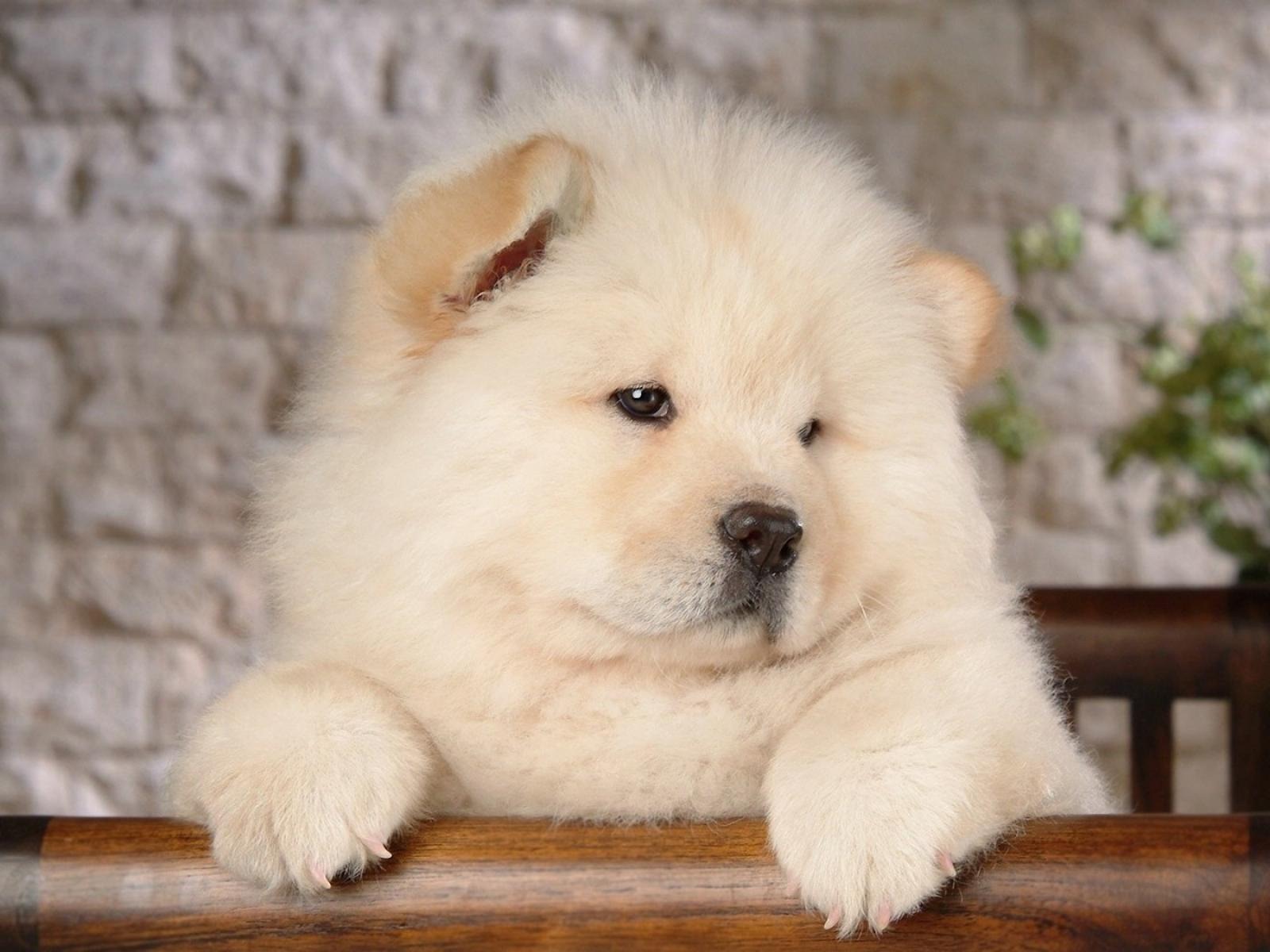
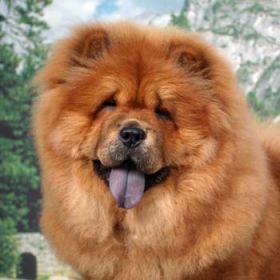


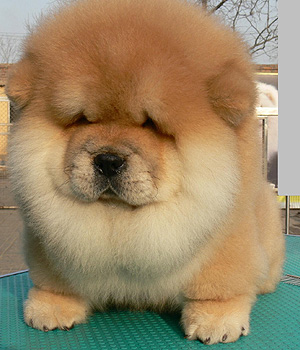
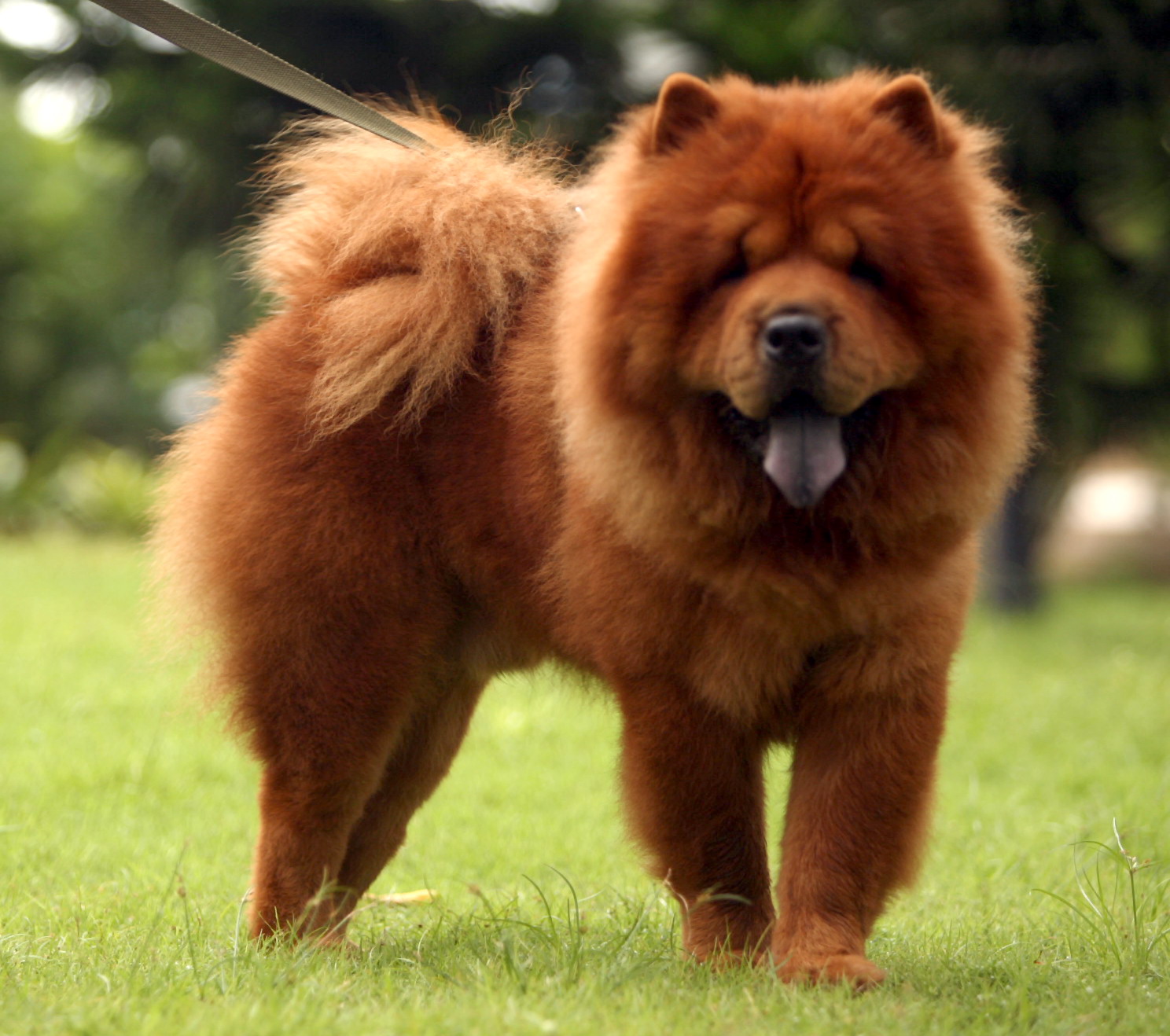

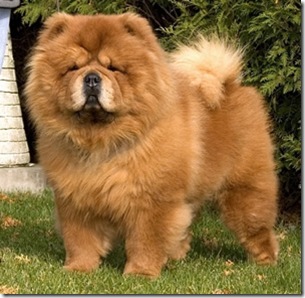
 Animalia Life
Animalia Life